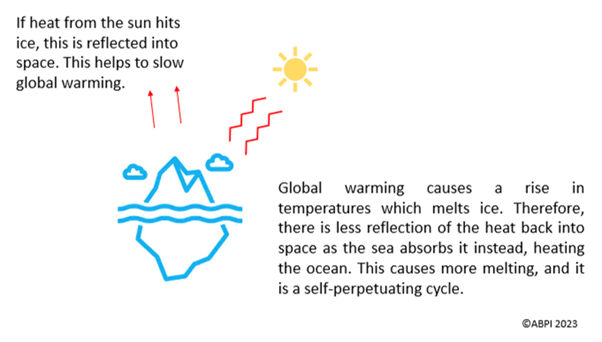This topic takes on average 60 minutes to read.
There are a number of interactive features in this resource:
 Biology
Biology
 Chemistry
Chemistry
 Physics
Physics
 Science
Science
Rising temperatures mean that more water is being evaporated into water vapour and drying out the land.
Water vapour itself is a greenhouse gas, and even though its production is natural, through evaporation, the earth getting hotter means that it is being made more quickly.
This then increases the earth’s temperature even more as water vapour can re-radiate the infra-red radiation that would usually return to space, trapping it in the atmosphere.
At lower temperatures, water vapour turns into clouds in a process called condensation. This is an example of the reversibility of changing states.
However, because the Earth is getting hotter, condensation doesn’t happen as much. This means that water evaporates but never turns from the water vapour gas back into the liquid water needed for rain.
This leads to droughts. As plants need water to grow, this can mean that crops cannot grow, and famine can happen.
Reduced rainfall can also reduce the drinking water available and can have a variety of health implications. For example, some diseases in less economically developed countries, such as cholera, are water borne. This means that people get the infections through drinking contaminated water, and this is much more likely when droughts happen as communities need to rely on contaminated water sources.
These implications are further exacerbated due to increased demand from a rise in the population density. Since 1900, there has been a 5-fold increase in water consumption. Combining this with global warming means that water is now less available than ever.
The water vapour will eventually be condensed when the temperature drops, which increases precipitation and makes flooding more likely. This excessive rainfall after periods of drought means that the water balance is off.
This means that the ice sheets and glaciers are melting much more quickly than the water is freezing.
The consequences of this are rising sea levels and animals losing their habitats. The rising sea levels can cause destruction of human homes too.
To put this into perspective, the Met Office state that between 1901 and 2018 the mean global sea level rose by 20cm and this will increase even more without appropriate action. This will have severe consequences for low countries such as Bangladesh, who will experience increased flooding. By 2050, Bangladesh may lose 11% of its land due to a 50cm sea level rise, according to the Climate Reality Project.
As changing states is reversible, melting ice caps and sea level rises are also reversible if global warming is slowed or reduced.

Temperature increases can cause the ocean water to expand too, whereby the particles gain energy and become more spread out but not enough for evaporation into water vapour. This is also causing rising sea levels.